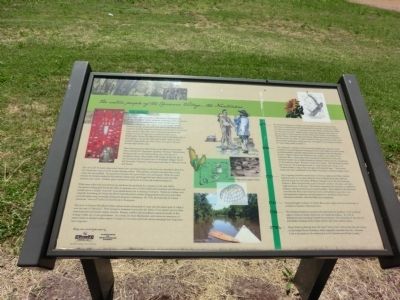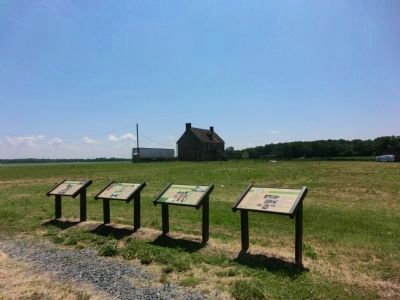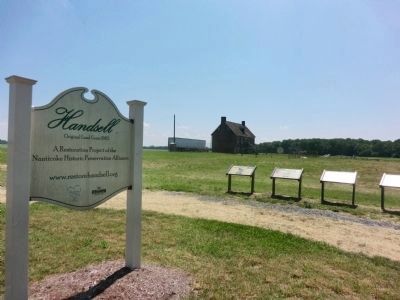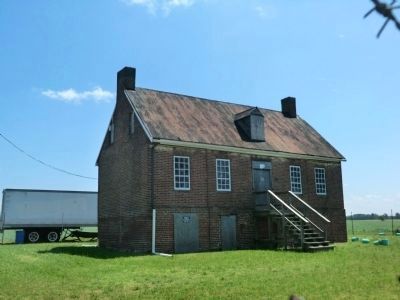Near Vienna in Dorchester County, Maryland — The American Northeast (Mid-Atlantic)
The native people of the Chicacone Village…the Nanticokes
Inscription.
Pre-History-For at least 2,500 years prior to the arrival of Europeans, the Eastern Woodland Indians inhabited a wide area in the eastern part of the United States including the vastly wooded area of the Delmarva Peninsula. This region is noted for ample rainfall, numerous ponds, streams, and rivers and the Woodland Indians tended to establish long-term settlements near water in the forested area, as well as other short-term settlements associated with traditional seasonal migrations to alternate food sources. Traditionally, Easter Woodland Indians live in dwellings built of bent saplings covered with mats and/or bark. Some of these would be single family size while others were quite extensive, housing larger family units.
There were numerous tribes living on the Delmarva Peninsula. These included the Algonquian speaking “Nentego” (Nanticokes), the largest tribe on the Eastern Shore, who were part of a matrilineal culture. John Smith’s 1608 voyage around the rim of the Chesapeake Bay described one of the largest villages, that of the Nanticoke “Emperor” which was in the area of Chicone Creek and Vienna.
They lived off the land, using wood, stone, bone and clay products as the basic raw materials in their lives. The Nanticokes were a hunter-forager-farming culture. Their primary animal foods were deer, turkey, turtle, fish, and shellfish. As experienced farmers they grew beans, corn, and squash. While the males hunted, the females worked in the gardens raising crops and foraged for nuts, berries, and roots like tuckahoe and cattail. Available plant material was used both for food and medicinal purposes.
While many tribes had moved freely up and down the peninsula for centuries, by the mid 1600’s, Europeans seeking land forced the tribes to abandon most of their traditional homelands and lifestyles and initially move to Indian “reserved” areas established by the Colonial government. Nanticoke Indians who originally lived along the Nanticoke River found themselves slowly being pushed north away from their ancestral lands, some eventually joining the Iroquois Confederacy. By 1769, all ownership of former Nanticoke “reserved” lands had transferred to Europeans.
The story of Eastern Woodland Indian culture reaches thousands of years into the distant past of what is now the state of Maryland. Their heritage is intimately woven into the fabric of our nation, yet it is often misinterpreted and remains largely obscure. Disease, conflict and assimilation wiped out much of this heritage within one or two generations. As a result, for most Marylanders and visitors an awareness of native culture is limited to place names of many of our towns and rivers whose meanings have long
since been forgotten.
1678-The Maryland Proprietary formally acknowledged a number of Eastern Shore town sites or informal reservations including the Nanticoke “Emperors” village of Chicone located nearby. If existing land patents already included these village sites they were honored. (English traders sometimes obtained patents to protect their economic interests and the Indians from further encroachment.) Thomas Taylor, a licensed trader and military officer obtained such a patent for 700 acres at this site which he called Handsell in 1665, upon which he built a local and no doubt prosperous trading post (the old English word, Handsell, translates to “earnest money handed at market.”).
1698-The Nanticokes experienced ever increasing English encroachment (social hostilities; hunting, fishing and foraging pressures; and English livestock rooting up Indian gardens) and had lodged numerous complaints with the Maryland Colony. English settlers were building houses nearby on the banks of the Nanticoke River. Christopher Nutter purchased Handsell from Taylor and assumed Taylor’s role as trader-interpreter; however, Nutter was less sympathetic to the Nanticoke plight. Tensions continued to mount. The Maryland Assembly passed an Act “for ascertaining the bounds of certain tract of land, to the use of the Nanticoke Indians, so long as they shall occupy
and live upon the same..” Reservation Lands were then established for the Native Americans at Chicone Indian Town.
1723-After acquiring Hansell from the heirs of Nutter, Captain John Rider claimed legal possession of the land within the Chicone Reservation after finding it deserted except for one Indian, William Ashquash, son of the late Nanticoke Emperor. Rider had physically ousted Ashquash, set fire to his cabin and built a clapboard house of his own. The Indians returned in the autumn, re-established residence and burned the house erected by Rider. They testified to the Maryland Assembly that Rider had found their towns uninhabited because they were following their traditional seasonal migration to alternative food sources. Maryland authorities ruled that Rider was trespassing.
1742-Ongoing English violation of Indian Reservation rights cause the Nanticokes to continue to abandon Chicacone town.
1768-The Maryland legislature passed a bill authorizing the purchase of all remaining rights to Chicone Indian lands from the Nanticoke Indians. In 1769 all Indiantown land including Handsell was returned to the ownership of the heirs of John Rider including Henry Steele and his wife Anne and her sisters.
1770’s-Henry Steele purchased from the other “heirs in law” and became the sole owner of the Indian Towne Purchase, which
originally extended from the “Chicacone Creek to the junction of the northwest fork of the Nanticoke near Walnut Landing.”
Erected by Maryland Heritage Area Authority.
Topics. This historical marker is listed in these topic lists: Anthropology & Archaeology • Colonial Era • Native Americans • Settlements & Settlers. A significant historical year for this entry is 1608.
Location. 38° 30.545′ N, 75° 48.768′ W. Marker is near Vienna, Maryland, in Dorchester County. Marker is on Indiantown Road. Touch for map. Marker is at or near this postal address: 4837 Indiantown Rd, Vienna MD 21869, United States of America. Touch for directions.
Other nearby markers. At least 8 other markers are within 2 miles of this marker, measured as the crow flies. The African American Story in the Indian Town (here, next to this marker); Handsell (here, next to this marker); The Nanticoke Historic Preservation Alliance (here, next to this marker); Unnacokossimmon (approx. 1.7 miles away); John Smith Explores the Chesapeake (approx. 1.7 miles away); Discover: Vienna Heritage (approx. 1.8 miles away); A walking tour of Vienna (approx. 1.9 miles away); Discover: Restoration (approx. 1.9 miles away). Touch for a list and map of all markers in Vienna.
Credits. This page was last revised on January 15, 2022. It was originally submitted on July 9, 2013, by Don Morfe of Baltimore, Maryland. This page has been viewed 1,210 times since then and 64 times this year. Photos: 1, 2, 3, 4. submitted on July 9, 2013, by Don Morfe of Baltimore, Maryland. • Bill Pfingsten was the editor who published this page.



